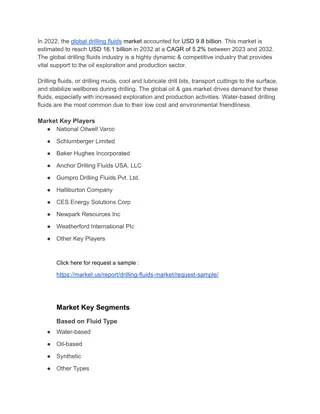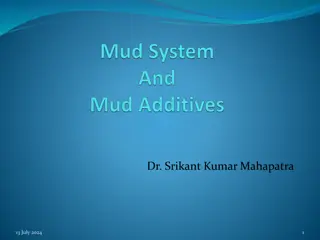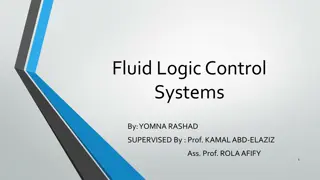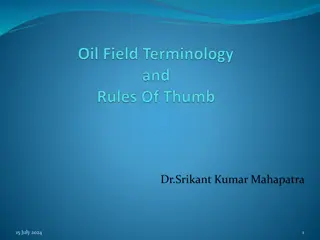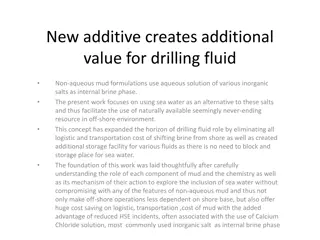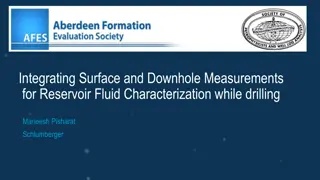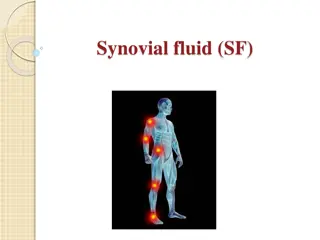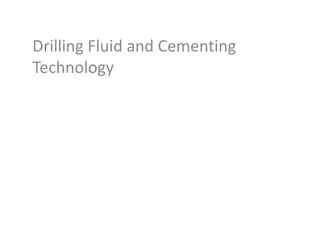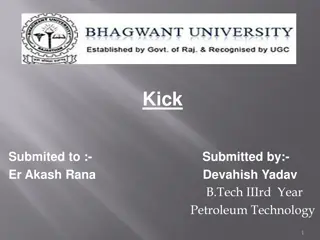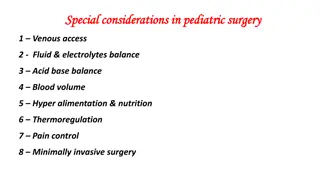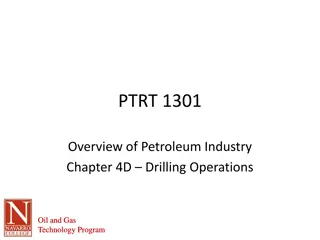Understanding Drilling Fluid Functions and Requirements
Drilling fluid plays a crucial role in the success of drilling operations by fulfilling various functions such as preventing hole collapse, controlling formation pressure, and maintaining wellbore stability. The fluid must effectively remove drill cuttings, cool and lubricate the drill string, and transmit hydraulic power to the bit. Additionally, a mud engineer is essential for optimizing the mud's weight, properties, and chemistry. Viscosity and velocity are critical factors that impact the efficiency of well cleaning and cuttings transport in drilling fluids.
Download Presentation

Please find below an Image/Link to download the presentation.
The content on the website is provided AS IS for your information and personal use only. It may not be sold, licensed, or shared on other websites without obtaining consent from the author. Download presentation by click this link. If you encounter any issues during the download, it is possible that the publisher has removed the file from their server.
E N D
Presentation Transcript
DRILLING FLUID FUNCTIONS An Introduction To Drilling Fluid Dr. Srikant Kumar Mahapatra Thursday, July 18, 2024 1
Requirements of a Drilling Fluid Prevent Hole collapse Seal Rocks to prevent loss of fluid Prevent rock dispersion Prevent the flow of oil and gas while drilling Remove drill cutting Avoid damage to the production zone Lubricate the drill string Thursday, July 18, 2024 2
Water Based and Oil Based Muds WBM OBM Thursday, July 18, 2024 3
DRILLING FLUID FUNCTIONS INTRODUCTION Mud Engineer Drilling fluids are becoming so specialized, most companies now have a mud engineer on duty at all times to keep the mud in good condition. The Mud Engineer: is responsible for testing the mud and for prescribing mud treatments in order to keep mud weight, properties, and chemistry within recommended limits. must give detailed recommendations in order to optimize the achievement of technical and economical drilling aims Thursday, July 18, 2024 4
DRILLING FLUID FUNCTIONS Should: Should Not: 1. Remove drill cuttings from wellbore 2. Control formation pressure 3. Maintain wellbore stability until casing can be run and cemented 4. Cool and lubricate drillstring and bit 5. Transmit hydraulic power to bit 6. Hamper formation evaluation techniques 7. Cause adverse effects on the formation being penetrated (Formation Damage) 8. Cause corrosion of the tubulars Thursday, July 18, 2024 5
DRILLING FLUID FUNCTIONS 1. Remove Drill Cuttings from Wellbore Viscosity Viscosity and fluid rheological properties have a determinant effect on well cleaning. Cuttings settle rapidly in low viscosity fluids (such as water) and as a result, their removal is difficult. Generally, higher viscosity fluids are required to improve cuttings transport capacity The property related to the viscosity is the thixotropy. It means that a mud (thixotropic fluid) can become like a gel under static condition and return to sol (fluid) in dynamic situation. This characteristic can suspend the cuttings during the situation when the mud is not being circulated, as for flow check or pipe connection or repairing Viscosity is dependent on concentration, quality, and dispersion of suspended solids in the mud. Thursday, July 18, 2024 6
DRILLING FLUID FUNCTIONS 1. Remove Drill Cuttings from Wellbore Velocity Definition: The rate (or speed) at which the mud is circulated (dependant on pump capacity, pump speed, borehole size, and DP size) The higher the fluid velocity the faster the cuttings will reach the surface Transport velocity = Annular velocity Slip velocity (More on velocity under Hydraulics section) Thursday, July 18, 2024 7
DRILLING FLUID FUNCTIONS 1. Remove Drill Cuttings from Wellbore Particle Suspension Drilling fluid must also keep drill cuttings in suspension when the mud is not being circulated (e.g., during a connection) The propety that keeps particles in suspension is called gel strength . Gel strength required to hold the cuttings in suspension should be no more than required however. When circulation resumes, the fluid must be fluid enough to release the particles at surface. Cuttings that settle when circulation has stopped can cause bridges that result in a stuck string. Thursday, July 18, 2024 8
DRILLING FLUID FUNCTIONS 1. Remove Drill Cuttings from Wellbore Thixotropic Definition: The property exhibited by certain gels of becoming fluid when stirred or shaken and returning to the semi-solid state upon standing. Most drilling fluids are thixotropic. This means that they undergo a gelification process in static conditions. This process allows the drilling fluid to keep cuttings in suspension during pipe connections and other times when the mud is not moving. Shear-thinning fluids with high viscosity are the most effective for well cleaning at low annular velocity. Thursday, July 18, 2024 9
DRILLING FLUID FUNCTIONS 1. Remove Drill Cuttings from Wellbore Density Density has a positive effect on removing drill cuttings: the higher the density of the mud, the more buoyancy. More buoyancy means greater carrying capacity to prevent the cuttings from falling through the mud and to lift them to surface High density fluids can clean the hole very well with low annular velocity However, a mud heavier than necessary to balance the formation pressure has a negative impact on drilling operations, so weighting up the fluid just to remove cuttings must be avoided Thursday, July 18, 2024 10
DRILLING FLUID FUNCTIONS 1. Remove Drill Cuttings from Wellbore USE THIXOTROPIC FLUIDS WITH SHEAR THINNING PROPERTIES WITH A STRONG LOW-SHEAR-RATE VISCOSITY (LSRV) AND PLUG FLOW CONDITIONS USE A HIGH FLOW, LOW VISCOSITY FLUID TO OBTAIN TURBULENT FLOW An easy method to determine if drilled solids are being effectively removed by the mud is to compare the sand content at the flow line and at the mud suction. Thursday, July 18, 2024 11
Remove Cuttings From the Well Bore The most important parameter is the Annular Velocity (A.V.) Where possible the annular velocity should be 100 ft/min, higher in deviated holes. In large hole sections the A.V. can be as low as 20 ft/min. If the A.V. is insufficient to clean the hole the viscosity must be increased For top hole high viscosities must be used Cuttings removal is harder in deviated and horizontal holes as the vertical component of the mud is reduced. A.V.(ft/min) = Pump rate (bbls/min) Annular vol (bbls/ft Slip Velocity (ft/min) = Cuttings velocity - A.V. Thursday, July 18, 2024 12
DRILLING FLUID FUNCTIONS 2.Control Formation Pressure Density One of the main functions of drilling fluid is to keep the formation pressure under control The pressure exerted by the mud column in static conditions (without circulation) is called hydrostatic pressure. Hydrostatic pressure is the product of the mud weight and the True Vertical Depth (TVD) of the well. If the hydrostatic pressure of the column of drilling mud is equal to or higher than the formation pressure, formation fluids can t flow into the wellbore Thursday, July 18, 2024 13
DRILLING FLUID FUNCTIONS 2.Control Formation Pressure Density Formation pressure typically increases with depth To compensate for this we increase the density of the mud with barite Mud weight must be limited to the minimum necessary to control the well, maintain its stability, and still stay below the fracture gradient Thursday, July 18, 2024 14
DRILLING FLUID FUNCTIONS 2.Control Formation Pressure Density The pressure gradient of a normal formation can vary from: 0.436 psi/ft [1.03 kg/cm2/10 m] (8,59 lb/gal) for onshore wells 0.465 psi/ft [1.07 kg/cm2/10 m] (8,95 lb/gal) for off-shore wells Thursday, July 18, 2024 15
DRILLING FLUID FUNCTIONS 3. Maintain Wellbore Stability Caving Wellbore stability is a function of mechanical, physical (pressure and tension), and chemical characteristics Overhangs, ledges, and vertically-dipping formations may break off and fall into the hole if a high differential (pressure or density) exists between the formation and drilling fluid Swelling clays and heaving shales decrease drilling rate, and increase the possibility of stuck pipe and fishing jobs Thursday, July 18, 2024 16
DRILLING FLUID FUNCTIONS 3. Maintain Wellbore Stability The cement job is a determining factor to effective isolation between formations, and to guarantee a reliable completion. The mud must maintain the condition of the hole so casing can be run and cemented without causing completion problems. When running casing, the mud must be fluid and at the same time minimize the annular pressure losses in order to avoid loss of circulation caused by induced fractures. Thursday, July 18, 2024 17
DRILLING FLUID FUNCTIONS 4. Cool and Lubricate the Drillstring and Bit Circulation of the drilling fluids cools the bit and the drillstring assembly, to temperatures lower than the bottom-hole temperature Mechanical and hydraulic energy generated by pumping mud to the bit, and abrasion between the drill string and the hole, produces a great amount of heat Since the formation is a poor conductor the heat has no where to go Circulating fluid helps to dissipate this heat at surface Because of the composition of the mud, it has a lubricating effect which also cuts down on the heat production. Indicators of poor lubrication are high torque and drag Thursday, July 18, 2024 18
DRILLING FLUID FUNCTIONS 5. Transmit Hydraulic Power to Bit Hydraulic Power is Used to: Maximize penetration rate (ROP) Remove cuttings from under the bit and up to the surface Run downhole motors and other special equipment The hydraulic program is based on using the right diameter nozzles in the bit, the pump s efficiency, and choosing the proper circulation pressures and rates for the hole conditions Thursday, July 18, 2024 19
DRILLING FLUID FUNCTIONS 6. GuaranteeAdequate Formation Evaluation Logging The type and composition of mud in the hole determines the quality of data from the electric logs that measure the electrical, sonic, nuclear and magnetic-resonance properties of the formations Precise formation evaluation is mandatory, without it we must core, run DSTs, and conduct flow tests. All these formation evaluation methods are affected by the drilling fluids. Thursday, July 18, 2024 20
DRILLING FLUID FUNCTIONS 7. Minimize Formation Damage Main Causes of Formation Damage Mud or drilling solids that invade deep into the matrix of the formation, permanently obstructing its porosity and permeability Swelling shales, which reduce permeability Precipitation of solids that result from the reaction between the mud filtrate and formation and completion fluids (such as brines or acids), which limit permeability Emulsions formed by contact between the mud filtrate and formation fluids, which can limit permeability Thursday, July 18, 2024 21
DRILLING FLUID FUNCTIONS 7. Minimize Formation Damage Seal off Permeable, Porous, and Fractured Fms Permeability is a measure of the capacity of a porous media (such as a rock) to allow fluid to flow through it. When the pressure of a mud column is greater than the formation pressure, liquid and solid components of the mud invade the formation and form a filter cake against the borehole wall In highly porous and permeable formations, the mud can easily invade the formation. Thursday, July 18, 2024 22
DRILLING FLUID FUNCTIONS 7. Minimize Formation Damage Filter Cake Solids in the mud will form a barrier (skin effect) on the borehole wall of the formation. The filter cake is composed of solids from the drilling fluid The filter cake should be thick enough to seal the formation, but it also must be thin enough to avoid causing drilling problems. Thursday, July 18, 2024 23
DRILLING FLUID FUNCTIONS 7. Minimize Formation Damage Potential Problems with a Thick Filter Cake Tight hole Increased torque and overpull Poor log quality Drillstring failure Thursday, July 18, 2024 24
DRILLING FLUID FUNCTIONS 7. Minimize Formation Damage Treating a Thick Filter Cake Calcium Carbonate (removable with acid washing) Cellulose And a wide range of seepage loss Other additives (LCM) Thursday, July 18, 2024 25
DRILLING FLUID FUNCTIONS 8. Control Corrosion Because the drill string and casing are constantly in contact with the drilling fluid and well fluids, they are constantly subject to corrosion Electrolysis, stress, contaminants such as soluble salts, dissolved oxygen, carbon dioxide, or hydrogen sulphide can cause severe corrosion, either deep in the well or on surface Use oxygen scavengers, scale inhibitors, ironite sponge, zinc oxide Easiest to maintain high pH: 9.5 to 10.5 Most solutions only slow the corrosion down, none can solve it Thursday, July 18, 2024 26
DRILLING FLUID FUNCTIONS In a drilling fluid system, the mud properties must keep the essential functions and at the same time minimise problems in the well. The topics developed in this chapter are a guideline for the selection of the fluid. The selection of a drilling fluid must be based on generic experience and developed in site experiences Thursday, July 18, 2024 27
DRILLING FLUID FUNCTIONS The selection regarding the type of mud is based on: Well Design Anticipated Formation Pressure and Rock Mechanics Formation Chemistry The need to limit damage to the production formation Temperature Environmental Regulation Logistics Econimics Thursday, July 18, 2024 28
DRILLING FLUID FUNCTIONS Mud Properties VS Functions The characteristics of a mud can influence its functions e.g. the formation pressure is checked by the hydrostatic pressure. The hydrostatic pressure is modified by the density or specific weight. As the uncontrolled density increases, the pressure drop increases. The consequence is a possible loss of circulation. Thursday, July 18, 2024 29
DRILLING FLUID FUNCTION Mud characteristics modifications Fluids engineering always need an exchange of conditions to treat and keep optimum drilling. For instance, an out of proportion viscosity increasing, improves the hole cleaning: The loss of pressure increases The capacity of removing solids in the mud decreases The penetrating rate slows down The dilution treating increases a/o the preparation, with consequent costs increasing Thursday, July 18, 2024 30
Mud Properties Measurement Thursday, July 18, 2024 31
Density The density is measured using a mud balance. The weight of a mud cup attached to the one end of the beam is balanced on the other end by a fixed counterweight and a rider free to move along a graduated scale. The density of the fluid is a direct reading from the scales located on both sides of the mud balance The units used for measuring density of drilling fluid are Specific Gravity, PPG, and psi/ft Thursday, July 18, 2024 32
Viscosity Viscosity of drilling fluid is measured using Marsh funnel and rotating viscometer. The Marsh funnel is a rig site instrument used to measure funnel viscosity. The funnel is dimensioned so that by following standard procedures, the out flow time of 946 ml of mud is measured using a graduated cup as a receiver. The unit used for viscosity measured with marsh funnel is seconds Thursday, July 18, 2024 34
In rotating viscometer Apparent Viscosity, Plastic viscosity and yield point are measured. Mud is contained in the annular space between the two cylinders. The outer cylinder or rotor sleeve is driven at a constant rotational velocity; its rotation in the mud produces a torque on the inner cylinder bob. A torsion spring restrains the movement of the bob. A dial attached to the bob indicates its displacement on a direct reading scale. Thursday, July 18, 2024 35
Gel Strength It is a measurement under static conditions of the forces in the mud which cause gel structure to develop when the mud is at rest. The gel strength is one of the important drilling fluid properties because it demonstrates the ability of the drilling mud to suspend drill solid and weighting material when circulation is ceased. Gel strength is determined using viscometer. The sample is stirred at high speed and then allowed to rest for 10 sec or 10 min. The torque reading at 3 rpm is taken as gel strength at specified time and expressed in lb/100 ft2. Thursday, July 18, 2024 36
Fluid Loss Fluid loss and filter cake thickness are measured using a standard API filter press. The API filter press consists of a cylindrical mud chamber. A filter paper is placed on the bottom of the chamber just above a suitable support. Below the support is a drain tube for discharging the filtrate into a graduated cylinder. API Filter Press for Testing Drilling Fluid Thursday, July 18, 2024 37
Oil & Solid Content In drilling fluid both drilled solids and weighting materials are present. The solid content is measure using Retort to know the total solids in the mud. Mud is placed in a steel container and heated at high temperature until the liquid components have been distilled off and vaporized. The vapors are passed through a condenser and collected in a graduated cylinder. Thursday, July 18, 2024 38
Sand Content Sand content affects mud density and apparent viscosity, equipment wear, bit life, drilling rate and formation damage. It is measured by carefully washing a measured volume of mud on a 200 mesh screen 2 in diameter. The material held on the screen is poured into a cone shaped graduated container. It is reported in percent by volume. Thursday, July 18, 2024 39
Chemical Analysis pH : Clay interactions, solubility of various components and contaminants, and effectiveness of additives are all dependent on pH, as is the control and sulfide corrosion process. The pH is measured by pH-meter or pH paper. Chloride : The chloride content of the mud is determined by titration of mud with silver nitrate solution using potassium chromate as indicator. mL of silver nitrate x 1000 Chloride, mg/L = ------------------------------------- mL of filtrate sample Calcium : It is determined by titration of mud or filtrate with versenate solution and calver-II as indicator at higher pH using KOH solution. mL of standard versenate 400 Ca++, mg/L = ------------------------------------------------ mL of filtrate Thursday, July 18, 2024 40
THANKS Thursday, July 18, 2024 41




